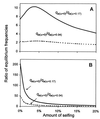Selection-mutation balance in polysomic tetraploids: impact of double reduction and gametophytic selection on the frequency and subchromosomal localization of deleterious mutations
- PMID: 10823890
- PMCID: PMC18675
- DOI: 10.1073/pnas.100101097
Selection-mutation balance in polysomic tetraploids: impact of double reduction and gametophytic selection on the frequency and subchromosomal localization of deleterious mutations
Abstract
We modeled the behavior of recessive mutations with deleterious effects to either the sporophyte or the gametophyte, or both, in polysomic tetraploid populations by allowing for varying levels of double reduction, mutation, and self-fertilization. Double reduction causes a decrease of the equilibrium frequencies of deleterious alleles, and it has much more influence on genes subjected to gametophytic selection than on genes solely under sporophytic selection. With gametophytic selection, low frequencies of double reduction are enough to reduce equilibrium frequencies severalfold. Double reduction occurs when sister alleles migrate to the same gamete during meiosis. It depends on the frequency at which a locus recombines with its centromere, and on the frequency of multivalent formation. Therefore, a greater accumulation of deleterious mutations should occur on polysomic chromosomes with a prevalence of bivalent pairing and in chromosomal regions between centromeres and proximal chiasmata. Proximal loci should have a greater impact in reducing the fitness of a polyploid population being inbred. This prediction can explain observations that homozygosities at different subchromosomal regions have distinct effects on inbreeding depression in polyploids. Furthermore, even mildly deleterious alleles can lead to large amounts of inbreeding depression because of their high equilibrium frequencies. Molecular studies correlating level of heterozygosity and degree of heterosis should take into account this nonuniform distribution of deleterious alleles in polyploid genomes. Preservation or enhancement of heterozygosity would be more critical at proximal regions than at other chromosome regions in polysomic polyploid species.
Figures





References
-
- Ramsey J, Schemske D W. Annu Rev Ecol Syst. 1998;29:467–501.
-
- Hilu K W. Am J Bot. 1993;80:1494–1499.
-
- Leitch I J, Bennett M D. Trends Plant Sci. 1997;2:470–476.
-
- Bretagnolle F, Felber F, Calame F G, Küpfer P. Bot Helv. 1998;108:5–37.
Publication types
MeSH terms
LinkOut - more resources
Full Text Sources

